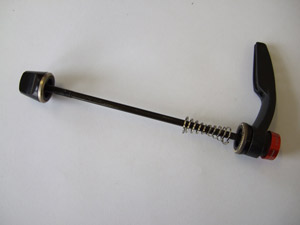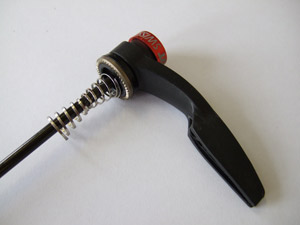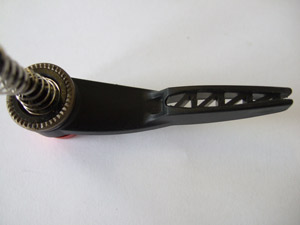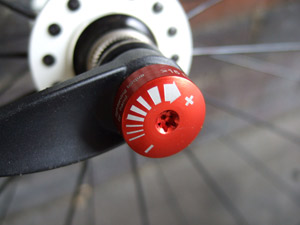 |
 |
DT Swiss RWS titanium quick-release skewer £39.99 each (steel £29.99)
The RWS skewer system from DT Swiss is designed to do away with the cam-operated quick release that has served cyclists so well for over three quarters of a century. About time too, you might say; that’s a long time for an engineering solution to keep the upper hand.
For sure, the traditional cam- (or, rather, eccentric-) operated quick release lever has been reinvented often enough, and given its invention by Tullio Campagnolo it is ironic that today, of the major manufacturers, only Shimano still offers something that looks like the original, which sites the lever offset to one side of the cap. That said, the mode of operation remains the same in the shape of the ‘flip’ action of said lever, which has to generate its clamping force via a short throw of some 160deg. This requires a high leverage ratio.
Instead, the RWS skewer lever rotates about the wheel axle; since it can be turned as many times as desired without fouling anything, it is possible to use a lower leverage ratio and, therefore, get greater clamping force for the same pressure on the lever.
This is not the first attempt at such a solution, but the problem is obvious; it is hard to predict where the lever will end up as it reaches the desired tightness. DT gets around this with an ingenious mechanism in the cap. Pulling the lever outwards disengages it from the cap so it can be rotated to the desired orientation. When let go, it springs back into the cap and stays nicely put.
 |
 |
The lever is moulded in a high-strength engineering plastic and is shaped with internal struts for rigidity. The cap mechanism is in light alloy and the skewer itself in either steel or titanium. Weight and cost varies accordingly.
In use, the lever does the job of securing the wheel as effectively as might be expected of a respected firm such as DT Swiss. Once tight, the lever is easily moved to the desired position. However, it is not obvious that this is a better way to do the job than the usual flip lever. As the RWS lever approaches the frame or fork, fingers can touch stays or fork legs as it rotates, whereas the flip lever moves through an unimpeded arc. The distance between the underside of the lever and the clamping face of the cap is small, so some rear dropouts with extended walls can prevent the lever seating at the desired angle. In some installations, perhaps where the skewer nut needs loosening to clear the rear derailleur, the extra turn compared to a flip lever needed to slacken the skewer can be irksome.
On the plus side, the RWS system is light, well-made and reliable and, in the right frame, entirely acceptable. However, it’s unlikely that the conventional Q/R will disappear anytime soon on the road.
Titanium skewer available in 100mm (36g), 130mm (39g) and 135mm lengths; steel, 100mm, 135mm, 140mm, 145mm.
Verdict
Lightweight alternative to conventional quick release levers
 Light, high-tech operation and looks
Light, high-tech operation and looks
 Not an obvious improvement on regular QR operation
Not an obvious improvement on regular QR operation








